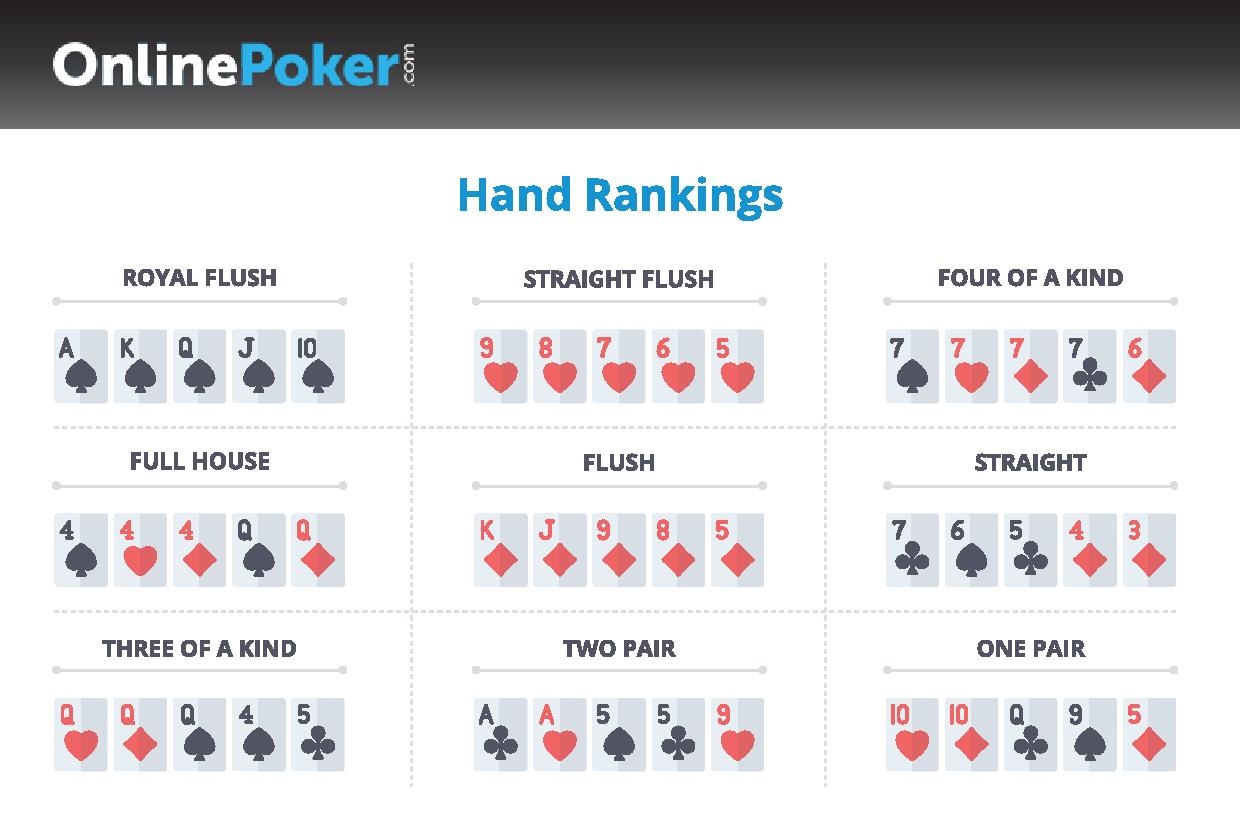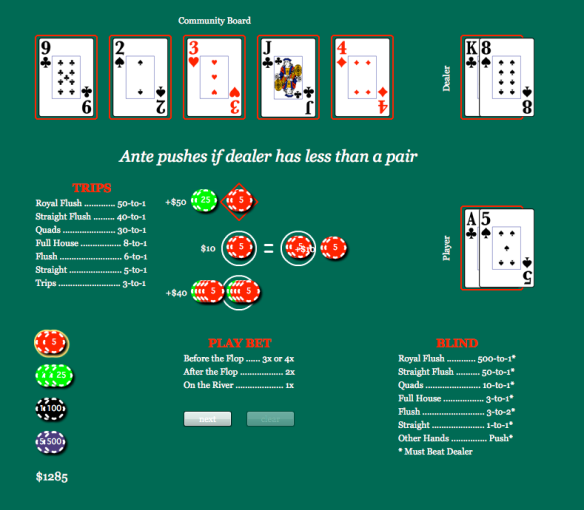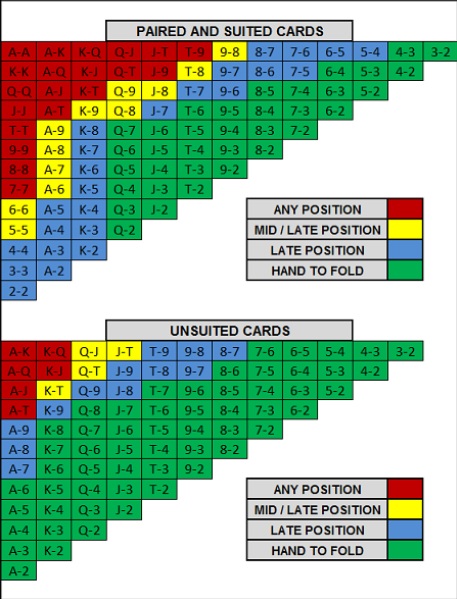Holdem Hands To Play
Aces – a pair of Aces is by far the best starting hand in Hold’em. However, if nothing improves from the community cards you only have a pair. It is quite rare, however, to ever go wrong with this hand preflop. Kings – a pair of Kings are almost as good as a pair of Aces preflop. Texas Holdem hands to play 1) AA. This the strongest hand you can have to start a game with, also called Pocket Aces. Once you have been issued. If you get this pair of cards as your starting hand, you should consider yourself lucky. Get the full course 55% off on you prefer, you can also watch it on Skillshare going to upload the les. According to some charts I’ve seen, if you’re dealt pocket kings, you actually. Aces are by far the best possible starting hand in hold’em, closely followed by Kings. However, you should be aware that even Aces or Kings can get cracked, and they don’t play too well against multiple opponents. This means you should definitely be raising pre-flop to narrow the field.
There are over one hundred possible starting hands in Texas Holdem ranging from the all powerful pocket aces to the fairly worthless 2/3 offsuit. Every one of these opening hands carries with it a unique set of strategies, strengths, weaknesses and other facets for when you decide to play those cards.
While it would be impossible to go over every possible opening hand to decide how best to play those cards, we can narrow the list down to a few tricky hands and cover how to play them. These cards were picked by me personally as opening hands I totally misplayed or succeeded at playing well. Ultimately, I learned a lot from them and I think you can learn from them, too.
Just be careful. It’s impossible to discuss every situation that will arise over the course of a full game of poker. In the end, you still need to use your best judgment and remember that bad beats will happen. Still, I think I can show you how to handle these opening hands better more often than not.
1- Pocket Kings
According to some charts I’ve seen, if you’re dealt pocket kings, you actually have an 83% percent chance to win the hand. Personally, I would like to find whoever put that that chart together and have some very strong words about what, exactly, I feel about being dealt pocket kings. Maybe I’m just the 17%, but I’ve never actually won when I’m dealt them.
Though, if I am being honest, a lot of the reason I lose with pocket kings is my own fault. It just feels like such a strong hand. Having a pair of anything in the hole is clearly better than having nothing in the hole when you start. (Even pocket 2s have a better than 50% chance of winning the day.) Still, pocket kings is far from unbeatable especially when your opponents are likely to play any hand with a pocket ace.
Even though I personally haven’t had luck with pocket kings, the strategy for playing them is fairly straight forward. If you don’t have position, you have enough firepower that you can play a strong opening bet. You don’t want to bet the farm, but you can definitely raise pre-flop with what you have if you’re aggressive, but definitely stay in the hand.
If you have position, pay attention to your opponents.
As far as the rest of the hand goes, you can continue to be aggressive, but be on the lookout for an ace. If a single ace hits the board, more than likely someone else is going to use that to make a pair of aces. Sadly, that is the voice of experience talking. If no ace hits the board, then you may be able to ride pocket kings to victory.
2- Ace/King Suited

Ace/king is another of those poker hands that gets a bad rap around the community. I think the reason for this is largely psychological because an ace and a king feel pretty good (they are the highest and second highest card in the game after all.) Unfortunately, they’re also not worth much because together they don’t even form a pair. So, their strength is largely illusory without some help.
With that said, there’s almost no reason that you don’t stay in with ace/king. I would have to be at a final table with everyone else going all in before I’d even think about folding ace/king and then I’d still probably push my stack and see what happened.
That’s really the key with ace/king: you’re not going to win pre-flop. You need help from the board to win, but you’re sitting in a really good position to let the board help you go on to poker glory. Therefore, as long as your bankroll management limit can support it, call any reasonable amount to stay and see what the flop gives you for it is on the flop that you will make your money.
Once the flop is down, that’s when you have a decision to make.
If any of that happens, stay in the game and bet according to the strength of your hand. If the other players are betting aggressive, you can back off, but you have a good chance of winning. On the other hand, if you flop nothing in your suit and nothing higher than a 9, you might want to get out of the hand since there’s a good chance someone else is working on a better hand than you.
Continue that logic through the next two cards. If you chances to win are high or if you have something, keep betting. If the cards aren’t falling your way, then don’t risk your money. Live to fight another day.
3- Ace/King Off Suit

Unsurprisingly enough, the strategy for ace/king off suit is largely the same as it is for ace/king suited, however the number of good post-flop hands fall off pretty dramatically since you will need at least four cards on the board to make a flush and, quite frankly, if you’re making a flush that way, so is everyone else.
Because of this, when I have ace/king off suit, I am mainly looking for flops that give me that chance at a straight. I certainly don’t mind pairs, but the table is likely to hold on to their hands if they have either a king or an ace. Therefore, if I have a pair, they probably have a pair and I end up splitting the pot. A straight is a much better way to ensure victory even though they are more rare.
4- Queen/Seven
Queen/seven isn’t the greatest starting hand, but having a face card to your name isn’t a bad thing, right? Actually, this is a deceptively poor hand and when you see this combination show up, the best thing you can do is fold.
I say “deceptively” because if this were a game of blackjack, a combined score of 17 is a pretty good hand (in fact, Queen/seven is the highest-scored blackjack hand that you want to fold.)

Holdem Hand Chart
According to computer simulations, queen/seven will only win about fifty percent of the time, which makes it unreliable.
Ultimately, that unreliability is this hand’s undoing. Even if you have position and everyone else is tepid, resist temptation and throw in your cards. The only reason to stay in is if you were the big blind and no one else bet. Then you could at least see if there’s something pre-flop.
5- Five/Four Suited
This is an autofold, right? Strangely enough, if you have position, five/four suited is the worst hand you could possibly consider keeping at least until you see the flop.

Why would you keep this hand? It offers two interesting ways to win. First, it sits in the middle of a straight (though clearly five/six suited would be better because then your hold cards could begin or end a straight) and it can be a nice seed for building out a flush. There’s also a very small chance a pair of fives win if most of the other players miss their draws.
I’m definitely not saying that you should play this hand every time. If you don’t have the position or if the table is betting fiercely, you don’t have a lot of strength in your hand and you probably won’t win any money. On the other hand, if the action is lukewarm, then it might make sense to stay in the hand and see what the flop gives you.
If the flop gives you four of the five cards you need for a straight, at that point, you can start to bet accordingly because chances are no one else has 4/5 in the hole and is not going for the same straight you are. Of course, if the flop doesn’t cooperate, fold and live to bet another day.
Conclusion
Poker can be cruel sometimes and the hands you think are the best sometimes just are not. That’s okay. That’s why you have a bankroll and that’s why you fold early so you can bet more later.
Still, hopefully when you are dealt any of the five hands above, you now have a better idea of whether you should stay in the game or runaway to play again later. Good luck and happy pokering.
NL Hold’em Starting Hand Charts
One aspect of the game of No-Limit Hold’em that causes beginning players much grief is deciding which hands to play and which hands to dump. NL Hold’em is much more difficult than Limit Hold’em because the value of a hand depends on so many factors other than just the cards in your hand. Despite this difficulty, our coaches believe that following some general guidelines and adjusting from these is a better solution than having no guidelines at all. Given that well over half of your profitability in NL Hold’em is based on hand selection alone, we have developed these charts to help you better determine whether to play or fold.
There are no perfect No-Limit starting hand charts. That is because there are many factors that affect your decision, and charts cannot account for all of them. Some of these include:
- The size of your opponent's stacks.
- How loose or tight, passive or aggressive, your opponents are.
- Where these opponents are located at the table – for example, does an aggressive player still have to act after you?
- Your image at the table – for example, how tight or tricky you are perceived.
That being said, these charts will serve you well in most typical low-stakes No-Limit cash games, such as games with blinds of $1/$2, and home games. These games typically have several loose players at the table, and good opportunities for winning big pots with suited connectors and pocket pairs. With practice, you will be able to be a consistently winning player with these charts as a starting point. As you improve, you'll find yourself making adjustments to these charts based on the factors listed above, and more.
AGAIN: These charts are a good starting point for beginners. Specifically, Chart #1 recommends a significant amount of limping. This is great in loose, passive games but less often seen in tougher games. You’ll find other training material on Advanced Poker Training that may recommend a more aggressive approach for more experienced players.
Note: It would be a serious mistake to apply these hand charts before reading the Frequent Asked Questions first.
CHART #1 ‐ LOOSE, PASSIVE GAME (OFTEN 4-5 LIMPERS PER HAND)
NO ONE HAS RAISED YET
- Raise Always
- Call from Early Position, otherwise raise
- Call always
- Call from Middle or Late Position if the conditions are right (see Frequently Asked Questions)

CHART #2 ‐ TIGHTER GAME (FEWER LIMPERS) OR MORE AGGRESSIVE GAME
NO ONE HAS RAISED YET
- Raise Always
- Call from Early Position, otherwise raise
- Call (or Raise) from Middle or Late Position if the conditions are right (see Frequently Asked Questions)
CHART #3 ‐ THERE HAS BEEN A SINGLE RAISE
(3‐5 TIMES THE BIG BLIND) BEFORE YOU
- Re‐Raise Always
- Call from Early Position, otherwise re‐raise
- Call always
- Call from Middle or Late Position if the conditions are right (see Frequently Asked Questions)
Holdem Play Poker Texas
FREQUENTLY ASKED QUESTIONS
For the hands in yellow, what do you mean when you say to play these hands if the conditions are right? The hands in yellow are speculative hands. They should always be folded from Early Position. From other positions, they can be profitable given the right conditions. Some of the questions to ask yourself:
- Are there other players who have called so far (the more, the better)?
- Are the players who have called playing poorly after the flop? Will they pay me off if I hit something?
- Is there an aggressive player still to act behind me (you might get raised and have to fold)?
- If there has been a raise and no other callers, what chance do I have of using my position after the flop to win the hand even if I don't improve (Chart #3 only)?
Why does Chart #2 say to sometimes raise with the hands in yellow, but Chart #1 does not? We have different goals in mind. Using Chart #1, we want to call to encourage additional players to enter the pot. These hands will be immensely profitable when our loose, passive opponents enter the hand, and get trapped when we flop a set, or make a well-disguised straight. When using Chart #2, however, we want to size up the opponents still to act. If they are tight, we can raise. Sometimes, we'll pick up the blinds. Other times, our pre-flop aggression will allow us to take down the pot on the flop.
What's the difference between AKs and AKo? AKs means an Ace and King of the same suit. AKo means an Ace and King of different suits.
What are early, middle, and late position? Early Position is generally the first 2 (in a nine player game) or 3 (in a ten player game) positions after the blinds. Late Position is the “cutoff” position (to the right of the dealer), and dealer button positions. Middle Position is everything in between.
How much should I raise? As a general rule, raise 3 to 4 times the big blind, plus 1 extra big blind for every player who has called before you. So if there are 2 callers already, raise between 5 and 6 times the big blind.
What if someone raises after I call? Whether you call the raise depends on how much money the raiser has for you to win, how many other players are involved, and what type of hand you have. As a general rule, if you have a pocket pair, lean towards calling. If there are a lot of other players (and therefore a big pot), lean towards calling. In general, fold suited connectors from early position. Fold hands like KQ that don't play well against a raiser.
How do I play from the blinds? From the small blind, play the same hands you would play from late position, plus a few more. But don't call with junk hands like T5o, just because it is “cheap”. From the big blind, if there is a raise to you, play like you would if you had already called from early position.
The chart says to fold KQo to a raise. Really? Yes, this hand performs very poorly against typical raising hands. Against AK, AQ, AA, KK, QQ, you are a big underdog. Other typical raising hands like JJ, TT, 99, AJs, are slightly ahead of you as well. The only time you might call or re-raise is from late position, if the opener was in middle or late position, indicating they might have a wider range of hands.
I was told to fold AJo from Early Position, why do you say to call with it? Folding AJo is not a bad idea in many games. We included it because, at low stakes tables (even tight or aggressive ones), the players are often playing badly enough after the flop that it can be profitable. We used data from millions of hands of low-limit poker to analyze this. The same could be said for KQo, ATs, and KJs – you can make a small profit in the long run at most low-stakes games, but folding would be perfectly acceptable from early position.
Can I use these charts in a NL Hold'em tournament? The charts would be best applicable to the early stages of a NL tournament, when everyone has a deep stack. In the middle and later stages, they should not be used.